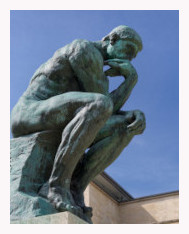 [NR] Hello, Kennita.
[NR] Hello, Kennita.
I’m a gallery-goer, not an artist. I’ve never had to write an artist’s statement, thank heaven, but I’ve read many, and too often they boil down to: “I’ve suffered for my art; now it’s your turn”. Does any artist ever write a statement by choice? Is it as integral to the work as a signature on a painting? An act of closure? I doubt it. I suspect it’s generally an external imposition, which brings a dull sense of obligation: “Oh, Lord… Here are 200 word-shaped holes I have to fill…” What else could explain how dreadful most artists' statements are?
As an ‘art consumer’, I want very little from an artist’s statement:• A one-line bio. • A few words on material or technique, if they are unusual enough to warrant. • A few words on the subject of the work, if the work is not representationally self-evident and its title not explicit or deliberately teasing.
What I don’t want is: “This was inspired by a childhood holiday in Cornwall, when my best friend’s cousin stole my teddy bear, which came from a shop in Nuneaton.” Nor do I want metaphysical maundering or overblown prose; words such as “journey” and “passionate” ring alarm bells. Now I’m starting to froth - but you get the idea.
[KT] Hi Nick! I love getting the perspective of a non-artist, gallery-goer, art-consumer!
I agree with a lot of what you have to say. And I suspect you’re right in that the artist most likely sees writing an artist statement as a chore. Probably even a dreaded one in the early stages of a career! I do believe, however, that the artist statement is immensely valuable to the artist, whether it’s realized at the time or not. Going through the writing process helps to solidify thoughts, directions, and meaning. Here’s my advice. Apply the KISSS rule: Keep it Short, Simple, and Specific.• Short being no more than two paragraphs in most circumstances.• Simple in language.• Specific to the point.
With KISSS in mind… Do include a bit about your medium, the materials you use (and why if it’s important to the piece).
Also, it’s important for an artist to remember that an artist statement is about the art, not the artist - that’s what the bio is for.
And oh - yes! Those alarm bells. • Don’t use words that imply or scream insecurity “I think…”, “I’m trying to…”, “I wanted to…”.• Resist the urge to start off with “I’ve been making art since I was 5 years old…”
Should we put together a list of alarm bells? Words and phrases to avoid? ..............
[NR] Kennita, it’s fascinating that you see the artist’s statement as helping to solidify thoughts after the work is completed. It’s a critique, then, rather than an original blueprint for the work?
“Trying” and “wanted” - yes, certain words sound the alarm. I’m also sensitive to the quantity of words, not just the quality. A good artwork arguably needs no words at all, because it already says everything that needs to be said.
You know Jules Feiffer's brilliant cartoons, in which his dancer tries to put into words the meaning which her inept dance routine fails to convey? That’s it: the more an artist tries to explain, the less I trust her art.
Here's my suggestion to artists. You’ve been given 200 words, say, for your statement. Don’t torture yourself: use just half of them. And be kind to us, your viewers and buyers: we haven’t come to admire the foam-board text Blu-Tacked beside your work. Let your art speak for itself. ..............
[KT] I see the artist statement as neither a critique nor a blueprint, Nick. I think of a critique as an analysis, evaluation; a blueprint as a plan. The artist may start with a plan, but as the art evolves, it usually changes. That change is what often brings life to a piece.
As far as needing no words at all, yes, if it sends a strong message or evokes a strong - visceral - emotion, like Dorothea Lange’s “Migrant Mother” or Chagall’s “The Birthday”, words would only be superfluous. Titles alone can also tell a story.
But, on the other hand, sometimes a further ‘explanation’ IS helpful. If a work draws from cultural influences that would not be obvious to someone not familiar with that culture. For instance, the viewer might not be aware of Andean symbolism or historical references - or British humor!
I think we’ve pretty much summed up what to include, what not to, and the importance of brevity. I know I’ll be thinking of your comments the next time I read (or write) an artist statement!
What is your view on artist's statements - do you think they add value or are they a pretentious irrelevance? Add your comments



Add your comment